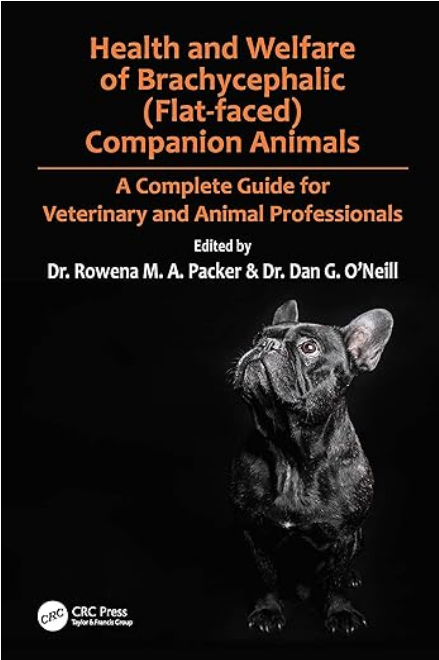Health challenges faced by brachycephalic pets
The post Flat-faced Dogs and Cats with Dr. Dan O’Neill and Dr. Rowena Packer at Companion Animal Psychology addresses a vital issue surrounding the health challenges faced by brachycephalic pets. But why is this so important for us to understand? These challenges impact the everyday lives of our beloved pets, often causing significant distress and complications.
First off, brachycephalic pets like Pugs, Bulldogs, and French Bulldogs are known for their adorable squished faces. However, this very feature creates a number of health problems. One of the main issues these pets face is breathing difficulties. When these pets are bred for their flat faces, it affects their ability to get enough air, leading to various respiratory issues.
According to Dr. Rowena Packer, “Breeding for that extreme face shape is basically anatomically not compatible with functional physiology, like the basics of being able to breathe and get oxygen into your lungs to stay alive.”

These breathing problems are not just minor inconveniences. They can seriously impact the pet’s quality of life. Some symptoms include constant panting, loud snoring, and a struggle to breathe, especially in hot weather. For example, flat-faced dogs are more prone to heatstroke due to their limited ability to cool themselves down by panting.
But breathing issues aren’t the only problems. Brachycephalic pets often suffer from eye problems due to their shallow eye sockets. Their eyes are more exposed and more likely to get injured or develop conditions like corneal ulcers. Additionally, skin fold dermatitis is common because of the excessive skin folds around their face and body, which create breeding grounds for infections.
These pets also face dental issues. The compact structure of their jaws can lead to misaligned teeth, causing eating difficulties and other oral health problems. Moreover, many of these breeds are prone to spinal issues because of their unusual body proportions. This can result in mobility issues and chronic pain.
“Lots of these breeds that we have are fine, but unfortunately, we have gone too far in many cases. And the dogs that we have BRED with brachycephaly, unfortunately, a lot of them do suffer.” — Dr. Dan O’Neill
Understanding these health challenges is crucial not just for veterinarians but for anyone considering adopting a brachycephalic pet. Awareness can lead to better care and make us rethink our breeding practices for the health and welfare of these animals. For more detailed insights and expert advice, don’t miss out on the full post on Flat-faced Dogs and Cats with Dr. Dan O’Neill and Dr. Rowena Packer.
Steps to improve the welfare of flat-faced breeds
When we discuss improving the welfare of brachycephalic pets, several key steps come to mind. It starts with responsible breeding practices. Breeders should focus on reducing the extreme features that cause health issues. For instance, Pugs and Bulldogs can still be adorable without excessively flat faces.
Proper Health Screenings
Breeders should do thorough health screenings before selecting dogs for breeding. This includes genetic tests to avoid passing on hereditary conditions. Regular vet check-ups are essential for spotting early signs of health problems. Proper screening can help reduce the occurrence of severe respiratory, dental, and ocular issues.
Better Breeding Standards
Organizations like the Kennel Club can implement better breeding standards. These standards should favor dogs with moderate physical traits that do not compromise health. Encouraging the breeding of dogs with more natural skull shapes and less extreme features can significantly improve their well-being.
- Encourage moderate physical traits
- Avoid selecting for extreme flat faces
- Promote genetic diversity to reduce hereditary conditions
Education for Potential Owners
Educating potential pet owners is another critical step. Many people fall for the cute looks of flat-faced breeds without knowing the health problems they may face. Information campaigns and resources can help spread awareness. This knowledge can lead people to make informed choices.
| Issue | Solution |
| Extreme flat faces | Select dogs with moderate faces for breeding |
| Breathing problems | Regular health check-ups and avoiding overly flat faces |
| Genetic issues | Conduct thorough health screenings and promote genetic diversity |
| Lack of owner awareness | Education campaigns and resources for potential owners |
| Skin Fold Dermatitis | Breeding for tighter skin and regular cleaning of skin folds |
Regular Veterinary Care
Regular veterinary care can’t be stressed enough. Brachycephalic pets need frequent checks to monitor their health. Vets can provide advice on managing conditions like heatstroke, skin fold infections, and dental problems. They may also recommend surgeries to improve breathing in severe cases.
Appropriate Exercise and Diet
Maintaining a healthy weight is crucial for these pets. Obesity can exacerbate breathing and joint issues. Owners should provide appropriate exercise and a balanced diet. However, exercise should be moderate to avoid putting too much strain on their respiratory system.
Owners should also be prepared for higher medical costs due to the increased health issues associated with brachycephalic breeds. This awareness can lead to more responsible pet ownership.
Improving the welfare of flat-faced breeds involves a combination of responsible breeding, education, and diligent care. By taking these steps, we can ensure that our beloved pets lead healthier, happier lives.
Insights from experts: Dr. Dan O’Neill and Dr. Rowena Packer
Expert Insights
Getting into the minds of experts often brings out fascinating insights. Dr. Dan O’Neill and Dr. Rowena Packer share a lot about the current status and future hopes for brachycephalic breeds. Their experiences help us understand not just the problems but the potential solutions.
First, let’s start with Dr. Rowena Packer, who has spent years studying this topic. She explains that the structure of brachycephalic dogs is like an obstacle course for air. Their anatomy makes it hard for them to breathe. The short muzzle, long soft palate, and narrow nostrils are some key issues. This “obstacle course” means these dogs struggle with even simple tasks like walking or sleeping.
“Breeding for that extreme face shape is basically anatomically not compatible with functional physiology.” — Dr. Rowena Packer
Dr. Dan O’Neill adds that these problems are due to recent changes in breeding practices. Unlike wild canines, domesticated dogs have been selectively bred for appearance rather than function. The result is a range of disorders, from breathing difficulties to eye and skin issues.
“In essence, we have taken this wonderful product of 10 million years of evolution and, in the space of a few hundred years, have gone and selected for mutations.” — Dr. Dan O’Neill
But the conversation isn’t just about problems. Both experts are hopeful for change. They believe that with better breeding practices, awareness, and management, the welfare of these pets can improve. Dr. O’Neill talks about “moderation” in breeding practices, which means not pushing for extreme features like flat faces.

Education as a Tool
One effective tool for change is education. Dr. Packer emphasizes the need to educate the public about what they are buying into when they choose a brachycephalic pet. Social media and advertisements play a huge role here. If people are more aware of the problems, they are less likely to encourage harmful breeding practices.
The experts also point out that change requires a collective effort. From breeders to pet owners to media houses, everyone has a role to play. While breeders need to adopt better practices, pet owners can push for healthier options by making informed choices. This collective push can help phase out harmful trends and promote the general welfare of pets.
For pet owners, a lot can be done at home. Maintaining a proper diet and regular vet visits are simple yet effective steps. Knowing what to look for in terms of health issues can also lead to earlier diagnosis and treatment. The experts stress that pet owners vigilant in providing care can greatly improve their pets’ quality of life.
“When you play God, you have to take responsibility for the outcomes.” — Dr. Dan O’Neill
There is a lot more to learn from Dr. Dan O’Neill and Dr. Rowena Packer’s expertise. They continue to advocate for healthier breeding practices and better education for pet owners. Their dedication shines through and provides a beacon of hope for the future.
Curious for more insights? Dive into the full post on Flat-faced Dogs and Cats with Dr. Dan O’Neill and Dr. Rowena Packer to get a detailed understanding.


